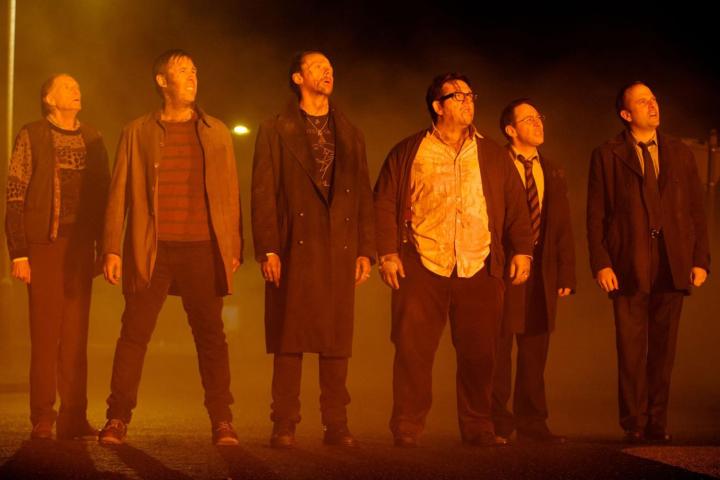
In a summer movie lineup crammed with enough highly sophisticated robots to make a terminator jealously kick a skull and go home, it’s somewhat telling that the best and most creative of the bunch may be a (relatively) low budget comedy set in a small town in England. Then again, it’s also from director Edgar Wright, so maybe the creative success isn’t all that surprising.
The World’s End concludes the “Three Flavours Cornetto” trilogy, that includes Shaun of the Dead and Hot Fuzz. The name stems from a “silly joke” based on something a reporter brought up during a Hot Fuzz interview, where he noted that the first two films both featured a packaged ice cream cone from Cornetto, and the two flavors in some way represented the film (the “flavor” of Shaun of the Dead was strawberry that came in a red wrapper, fitting the gore, while the blue packaging of the original cone represented the police blue of Hot Fuzz). The name caught on and came to represent this trilogy of thematically linked films that now concludes with The World’s End (which is represented by a green mint chocolate chip wrapper).
“There are robots, creepy kids, and it all revolves around a man named Gary King who never grew up.”
The World’s End is a deconstruction of a genre film. Where Shaun of the Dead was a twist on zombie horror and Hot Fuzz reworked the buddy cop genre, The World’s End is a comedic riff on films like Invasion of the Body Snatchers. If by some lucky chance you haven’t had the full plot spoiled for you yet, try to keep it that way. Just know there are robots, creepy kids, and it all revolves around a man named Gary King who never grew up.
Gary (played by Pegg) is a wreck of a man, irresponsible and wild, clinging to the vestiges of a childhood in which he discovered that being a “free spirit” was cool. That attitude hasn’t served him well as an adult on the far side of 40 though. Gary is one part force of nature, one part shattered mess. He’s delusional and obnoxious, but occasionally he’s also charming and endearing.
One of Gary’s last great days was in 1990, when he and his four best friends decided to celebrate finishing school by embarking on a pub crawl through 12 bars in their hometown of Newton Haven. Despite having a memorable night, they never finished. Through lies and trickery, Gary manages to convince his old friends Oliver (Martin Freeman), Peter (Eddie Marsan), Steven (Paddy Considine), and his former best friend Andrew (Nick Frost) to join in finally completing the pub crawl, which concludes at the bar, The World’s End.
As the evening goes on and the beers go down, the former friends begin to discover that something is off. Between rounds, the group discusses whether the town has changed or they have – then they fight a group of robotic kids with detachable heads. That pretty much answers that question. Joined by Oliver’s sister Sam (Rosamund Pike), they make their way from bar to bar, learning more about the town’s mystery with each stop. Then it all goes tits up.

The film starts out with a maudlin tone and hides its true intention underneath a veneer of middle-aged men trying to reconcile their present with the past. Gary is representative of this: he still dresses as he did when he was 18, still drives the same car, and still listens to the same cassette tape he was given more than 20 years ago. Gary is a loser that thinks he’s the hero of every story, which makes him pitiable in the eyes of his more successful and mature friends. Then the film suddenly, and radically, changes. Wright and company manage to combine a believable mid-life crisis film with a robot invasion, and it all works.
Pegg owns the role of Gary, from his movements to his banter with the others. There is an air of desperation hidden under the “free spirit” persona, and that leads to a surprisingly cathartic ending. But it’s really Frost that steals the movie, and this is the most well-rounded character he has portrayed under Wright’s direction. His transformation as the stiff and professional Andrew into the atomic elbow dropping fighter is perfect for the film.
“The thing that sets the Cornetto trilogy apart from other films is Wright.”
As good as Pegg and Frost are though, it all comes back to Wright. He has a style that is distinctive and unique, whether it’s in his TV show Spaced or his work on Scott Pilgrim vs. the World. Nothing is included in a shot if it doesn’t some meaning. People in the background are later turned into a visual gag. There’s life and color in every scene, and there’s a deliberate and curated feel to everything you see and hear. Nothing happens by accident, it’s all part of Wright’s plan.
Wright is a master filmmaker, and The World’s End manages to take a $20 million budget and offer a sci-fi story that is every bit as compelling as a film with 10 times the budget. The visual effects don’t feature a major city being destroyed, but they don’t need to.
Conclusion
The World’s End is steeped in originality and creativity, something sorely lacking in most films these days. He’s a master of deconstructing a genre film and honoring it, while still finding ways to pick it apart and make it funny. His filmography is littered with examples, including the other Cornetto films. The World’s End is another example of that formula, and it’s also one of the best films of the summer.
(Images and video © Focus Features. All rights reserved.)





